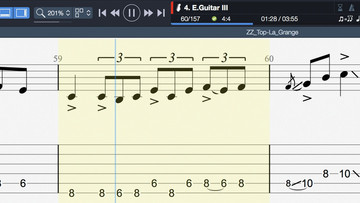

Select the ‘Progressive Speed’ option and in the ‘From’ section, enter your starting tempo: You can now select ‘Custom Values’ from the dropdown menu to bring up the speed trainer: This lets you control the playback speed of the song you’re working on. Now click the relative speed button to the right of the looping icon (or press Ctrl + F9): You can adjust the highlighted section to make sure it sounds natural every time the loop repeats. Do this and make sure you’re happy with how it sounds. If you hit play, Guitar Pro will repeat this highlighted section over and over. Once you find a suitable starting tempo, first enable looping by clicking this button (or press F9 on your keyboard): At this tempo, the scale run will feel easy and I can focus on making sure I play every single note in perfect time with what I hear from Guitar Pro. In this example, let’s say I can already play the scale run comfortably at 120bpm.Ī good starting place for my initial tempo if I can already play at 120bpm would be 90 or 100 bpm. Start at a tempo that feels too easy, then as the speed trainer gradually increases the tempo, it will bring you to a range that really starts to push your abilities. Starting the speed trainer at a slow tempo lets you ease into the practice and focus your attention on playing every note perfectly. The best approach is to start the speed trainer at a tempo lower than what you feel comfortable playing. So if you find that you get stuck jumping into a fast solo from the rhythm parts, highlight one or two bars before the solo and practice changing from rhythm into the solo. This is a great way to get used to incorporating complicated parts into the rest of the song. The last option is to include some of the song before the part you want to practice. Highlight one section of the solo and work on it for a while before moving on to the next section. So if you’re practicing a long solo, break the solo down into small sections. The second option is to break the section into parts and work on one part at a time. Anything longer and you’ll probably be better off in the beginning by breaking it into parts. This is the best approach for short licks or scale runs that last up to 3 or 4 bars.

The first option is to select the entire lick and use the tool to repeat it over and over.

You have a few options when working on something like this. In the below screenshot, I’ve highlighted a scale run I want to practice: To use this tool, start by highlighting the section you want to work on. Step 1: Highlight a part you want to practice This gradual building up of tempo is how you can eventually learn lightning-fast licks and scale runs with ease. The speed trainer allows you to start at a tempo where you feel confident playing the lick, then it will repeat it over and over while gradually raising the tempo.Įvery time you repeat the lick, you’ll be playing it slightly faster. This is where Guitar Pro 7’s Speed Trainer comes in. Repetition is how you push something from “good enough” to “mastered”.īut merely playing the lick or solo over and over isn’t going to push you to a higher skill level. When it comes to learning complicated guitar parts, repetition is king. Then accelerate step by step before reaching the normal tempo.3.6 Related Guides and Lessons: Method 1: Use the Speed Trainer to work on difficult riffs, licks, or solos To play this solo correctly, use the Guitar Pro 7.5 Speed Trainer to slow down the score.
#Guitar pro 7.5 speed trainer how to#
Take a look at Dan’s video to learn how to do that more easily.Īccess the free backing track here. For instance, play the fourth note and then slide to the second position on the fifth note. How and where does Clapton links these shapes? He links them in a very specific place, between the fourth and the fifth degrees of the scale. Knowing where the roots and flat thirds are will help you hugely. You will have to come back to the root note afterward. When improvising, you can end a phrase on the root, it will sound very complete. Then try to pinpoint the root notes, symbolized by an “R” on the diagrams and try to memorize them. For instance, when playing the first box of the scale, play the root on the low E string with your index and play the next note, the flat third (b3), with your little finger. Practice these shapes using one finger by fret.


 0 kommentar(er)
0 kommentar(er)
